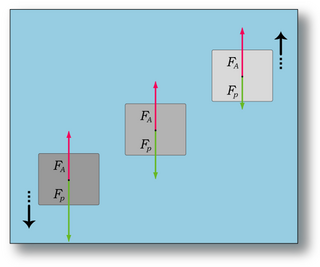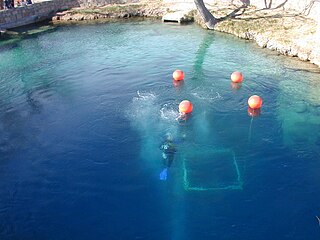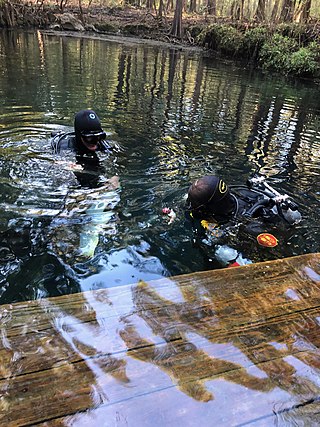
Spearfishing is fishing using handheld elongated, sharp-pointed tools such as a spear, gig, or harpoon, to impale the fish in the body. It was one of the earliest fishing techniques used by mankind, and has been deployed in artisanal fishing throughout the world for millennia. Early civilizations were familiar with the custom of spearing fish from rivers and streams using sharpened sticks.

Diving activities are the things people do while diving underwater. People may dive for various reasons, both personal and professional. While a newly qualified recreational diver may dive purely for the experience of diving, most divers have some additional reason for being underwater. Recreational diving is purely for enjoyment and has several specialisations and technical disciplines to provide more scope for varied activities for which specialist training can be offered, such as cave diving, wreck diving, ice diving and deep diving. Several underwater sports are available for exercise and competition.
Audrey Mestre was a French world record-setting freediver.

Scuba diving is a mode of underwater diving whereby divers use breathing equipment that is completely independent of a surface breathing gas supply, and therefore has a limited but variable endurance. The name scuba is an anacronym for "Self-Contained Underwater Breathing Apparatus" and was coined by Christian J. Lambertsen in a patent submitted in 1952. Scuba divers carry their own source of breathing gas, usually compressed air, affording them greater independence and movement than surface-supplied divers, and more time underwater than free divers. Although the use of compressed air is common, a gas blend with a higher oxygen content, known as enriched air or nitrox, has become popular due to the reduced nitrogen intake during long or repetitive dives. Also, breathing gas diluted with helium may be used to reduce the effects of nitrogen narcosis during deeper dives.

Snuba is form of surface-supplied diving that uses an underwater breathing system developed by Snuba International. The origin of the word "Snuba" may be a portmanteau of "snorkel" and "scuba", as it bridges the gap between the two. Alternatively, some have identified the term as an acronym for "Surface Nexus Underwater Breathing Apparatus", though this may have been ascribed retroactively to fit the portmanteau. The swimmer uses swimfins, a diving mask, weights, and diving regulator as in scuba diving. Instead of coming from tanks strapped to the diver's back, air is supplied from long hoses connected to compressed air cylinders contained in a specially designed flotation device at the surface. Snuba often serves as a form of introductory diving, in the presence of a professionally trained guide, but requires no scuba certification.
Defenses against swimmer incursions are security methods developed to protect watercraft, ports and installations, and other sensitive resources in or near vulnerable waterways from potential threats or intrusions by swimmers or scuba divers.

Rosalia (Zale) Parry (1933-) is an American pioneer scuba diver, underwater photographer and actress.

A dive center is the base location where recreational divers usually learn scuba diving or make guided dive trips at new locations. Many dive centers operate under the guidelines of ISO 24803, in which case the facilities must meet the ISO minimum standard for a service provider for recreational diving.

Canoe diving and Kayak diving are recreational diving where the divers paddle to a diving site in a canoe or kayak carrying all their gear in or on the boat to the place they want to dive. Canoe or kayak diving gives the diver independence from dive boat operators, while allowing dives at sites which are too far to comfortably swim, but are sufficiently sheltered.

Neutral buoyancy occurs when an object's average density is equal to the density of the fluid in which it is immersed, resulting in the buoyant force balancing the force of gravity that would otherwise cause the object to sink or rise. An object that has neutral buoyancy will neither sink nor rise.
Johnson Outdoors Inc. produces outdoor recreational products such as watercraft, diving equipment, camping gear, and outdoor clothing. It has operations in 24 locations worldwide, employs 1,400 people and reports sales of more than $315 million. Helen Johnson-Leipold, one of Samuel Curtis Johnson, Jr.'s four children, has run the company since 1999.
Pascal Bernabé is a French scuba diver who in 2005 laid claim to the world best for depth on a deep dive using self-contained breathing apparatus. Bernabé claimed to have reached a maximum depth of 330 metres (1,080 ft) using trimix on 5 June 2005 near Propriano, Corsica. This was actually deeper than the official deepest scuba dive recognized by Guinness World Records at the time. That mark, set by Nuno Gomes in Dahab, Egypt, was 318.25 metres (1,044.1 ft) of sea water. However, Bernabé's claimed deepest dive was not included in the Guinness Book of World Records due to insufficient evidence of such a dive ever being performed.

Aqua Lung International is a large and well-known firm which makes scuba and other self-contained breathing apparatus, and other diving equipment. It produced the Aqua-Lung line of regulators, like the CG45 (1945) and the Mistral (1955), among others. Until 2016, the company was a division of Air Liquide since its foundation in 1946. The company was sold to Montagu Private Equity in 2016.

The Blue Hole of Santa Rosa, or simply the Blue Hole, is a circular, bell-shaped pool or small lake located along Route 66 east of Santa Rosa, New Mexico that is a tourist attraction and swimming venue, and one of the most popular dive destinations in the US for scuba diving and training. The Blue Hole is an artesian well and cenote that was once used as a fish hatchery.

William "Bill" Hogarth Main is a cave diving pioneer who is best known as a developer in the 1980s, and the namesake of, the "Hogarthian gear configuration" that is a component of the "Doing It Right" (DIR) holistic approach to scuba diving. According to Jarrod Jablonski, the Hogarthian style "has many minor variations, yet its focus asserts a policy of minimalism." The configuration was refined in the 1990s, partially through the Woodville Karst Plain Project (WKPP), established in 1985 and considered among the most aggressive cave diving initiatives in the world.

Eduard Admetlla i Lázaro was a Spanish scuba diving pioneer, underwater cameraman and photographer, designer of underwater camera housings, designer of a self-contained underwater breathing apparatus (scuba), tester of scuba diving gear for the Nemrod trade mark, writer, director of TV series, explorer and broadcaster.
In underwater diving, a downline is a piece of substantial cordage running from a point at the surface to the underwater workplace, and kept under some tension. It can be used as a guideline for divers descending or ascending, for depth control in blue-water diving, and as a guide for transfer of tools and equipment between surface and diver by sliding them along the downline at the end of a messenger line. A shotline is a special case of downline which uses a heavy weight at the bottom and a float at the top. A jackstay is a more lateral equivalent, that commonly follows a surface, and will not usually allow materials transfer without a messenger line from the destination end.

A scuba cylinder valve or pillar valve is a high pressure manually operated screw-down shut off valve fitted to the neck of a scuba cylinder to control breathing gas flow to and from the pressure vessel and to provide a connection with the scuba regulator or filling whip. Cylinder valves are usually machined from brass and finished with a protective and decorative layer of chrome plating. A metal or plastic dip tube or valve snorkel screwed into the bottom of the valve extends into the cylinder to reduce the risk of liquid or particulate contaminants in the cylinder getting into the gas passages when the cylinder is inverted, and blocking or jamming the regulator.
Low impact diving is recreational scuba diving that is intended to minimise environmental impact by using techniques and procedures that reduce the adverse effects on the environment to the minimum that is reasonably practicable for the situation. To a large extent this is achieved by avoiding contact with sensitive reef life, but it also applies to diving on historical wrecks and in caves with delicate rock formations. It is in the interests of diving tourism service providers to help protect the condition of the dive sites on which their businesses rely. They can contribute by encouraging and teaching low impact diving and following best-practice procedures for diving in sensitive areas. Low impact diving training has been shown to be effective in reducing diver contact with the bottom, the most common cause of reef damage.
Dottie May Frazier was an American diver, designer, and dive shop owner. Her life is chronicled in her autobiography, Trailblazer: The Extraordinary Life of Diving Pioneer, Dottie Frazier. She was the first female scuba instructor and the first female dive shop owner.













